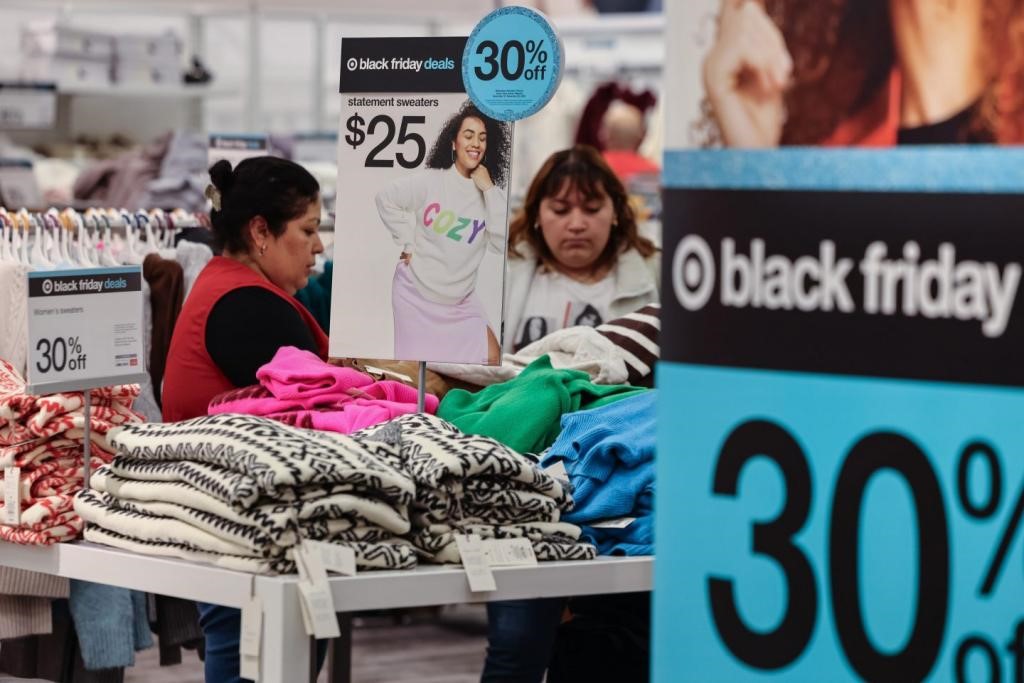
來自明尼蘇達州的塔吉特(Target)正在繼續采用其熟悉的自營品牌策略,該策略為公司創造了300億美元年銷售額。但現在,他開始向其他零售商投放其自營產品,沒有走競爭對手的老路。
該連鎖超市在周一宣布,計劃在哈德遜灣公司(Hudson’s Bay Co.)的85家加拿大連鎖超市豐富其Cat & Jack系列童裝,將在該品牌1,400種商品中增加外套和鞋子。該品牌的商品大多數售價低于15美元。塔吉特表示,自從今年3月兩家公司建立合作伙伴關系以來,該品牌在加拿大日益受歡迎,使哈德遜灣公司的購物籃系數增長了15%。
雖然塔吉特沒有計劃在美國推廣其自營品牌,但擴張Cat & Jack品牌是該公司在可自由支配收入減少時贏得消費者的最新策略。今年2月,塔吉特推出了一個新低價品牌Dealworthy,出售10美元以下的家居用品。2023年,塔吉特的銷售額下滑了1.7%,降至1,058億美元。
塔吉特未能像競爭對手沃爾瑪一樣增長市場份額。雖然兩家公司的策略有些趨同,但沃爾瑪的銷售額卻在穩定增長。上周,沃爾瑪推出了一個食品雜貨自營品牌,3月,塔吉特模仿Amazon Prime和Walmart+,推出了付費回饋計劃“Target Circle 360”。
零售商發展自營品牌,這并不意外。CivicScience在2023年9月的一份報告顯示,約60%的購物者表示,他們至少會較為頻繁的購買自營品牌商品。據市場調研公司Circana統計,2023年,自營品牌銷售額增長6%,達到2,170億美元。但專家表示,雖然零售商會相互借鑒,并參考消費者的意見上架自營品牌,但塔吉特卻采取了一種更加不同尋常的做法。
打破慣例
市場營銷公司Crew Marketing Partners的創始人兼CEO布雷登·道格拉斯對《財富》雜志表示,塔吉特在自有商店以外擴張自營品牌的做法并不受歡迎。
他說道:“這并不常見,因為其他大多數零售商不想幫助競爭對手增加收入。”
糟糕的經濟環境意味著大賣場零售商為了吸引消費者,更有可能承擔戰略風險。對于塔吉特而言,此舉是合理的選擇。道格拉斯表示:塔吉特有可靠的供應鏈,可以靈活地進行擴張,但塔吉特的業務幾乎集中在美國,這成為一個制約因素。2013年,塔吉特從哈德遜灣公司收購了200多家Zellers(一家倒閉的連鎖零售商)的租約,進軍加拿大市場。由于塔吉特的快速擴張,該筆收購預計到2021年才能實現盈利。但塔吉特在不到兩年后就關閉了所有加拿大連鎖店。擴大在哈德遜灣公司銷售的自營品牌種類,讓塔吉特可以重新在北方鄰國進行艱難的嘗試。
道格拉斯說道:“市場上仍有很大需求。我很高興看到他們愿意重新進行嘗試。”
經過估算的風險
北卡羅來納大學教堂山分校(University of North Carolina at Chapel Hill)克南-弗拉格勒商學院(Kenan-Flagler School of Business)的市場營銷教授卡特琳·吉耶朗斯表示,雖然塔吉特采用了非同尋常的自營品牌策略,這并不意味著這種策略沒被使用過。塔吉特也銷售競爭對手的自營品牌商品,包括連鎖藥店博姿(Boots)的護膚品牌NO7。吉耶朗斯曾經見過全國食品雜貨連鎖店采取類似措施,成功將注重健康的自營品牌投放到小型地區性商店。
吉耶朗斯同意道格拉斯的觀點,認為競爭對手在彼此的商店內投放自營品牌商品的情況并不常見。但她表示,在新的地區拓展自營品牌,或者吸引特定人群,是一種低成本的增加曝光度的方式,因為大規模購買和分銷自營品牌,往往具有節約成本的優勢。
她說道:“你需要有一定的信譽;還要有專業技能和知識。這并不容易實現。”
吉耶朗斯表示,從2008年至2012年,向其他零售商拓展自營品牌的做法變得日益常見,而且這種趨勢往往會出現在經濟動蕩時期。自營品牌不僅能在經濟衰退時期提供一種有效的銷售策略,即使在經濟衰退結束之后,對自營品牌的興趣通常也能持續多年。福布斯根據尼爾森(Nielsen)和信息資源公司(Information Resources, Inc.)的數據稱,各零售商的自營品牌從2008年至2022年創造了約350億美元收入。
由于通脹依舊頑固,消費者信心低于疫情之前的水平,因此吉耶朗斯預計會有更多公司采取與塔吉特類似的甚至更冒險的舉措,充分利用自營品牌。
她說道:“這時候人們就會更愿意探索和考慮價格略低的商品。這是恰當的機會窗口。”(財富中文網)
翻譯:劉進龍
審校:汪皓
來自明尼蘇達州的塔吉特(Target)正在繼續采用其熟悉的自營品牌策略,該策略為公司創造了300億美元年銷售額。但現在,他開始向其他零售商投放其自營產品,沒有走競爭對手的老路。
該連鎖超市在周一宣布,計劃在哈德遜灣公司(Hudson’s Bay Co.)的85家加拿大連鎖超市豐富其Cat & Jack系列童裝,將在該品牌1,400種商品中增加外套和鞋子。該品牌的商品大多數售價低于15美元。塔吉特表示,自從今年3月兩家公司建立合作伙伴關系以來,該品牌在加拿大日益受歡迎,使哈德遜灣公司的購物籃系數增長了15%。
雖然塔吉特沒有計劃在美國推廣其自營品牌,但擴張Cat & Jack品牌是該公司在可自由支配收入減少時贏得消費者的最新策略。今年2月,塔吉特推出了一個新低價品牌Dealworthy,出售10美元以下的家居用品。2023年,塔吉特的銷售額下滑了1.7%,降至1,058億美元。
塔吉特未能像競爭對手沃爾瑪一樣增長市場份額。雖然兩家公司的策略有些趨同,但沃爾瑪的銷售額卻在穩定增長。上周,沃爾瑪推出了一個食品雜貨自營品牌,3月,塔吉特模仿Amazon Prime和Walmart+,推出了付費回饋計劃“Target Circle 360”。
零售商發展自營品牌,這并不意外。CivicScience在2023年9月的一份報告顯示,約60%的購物者表示,他們至少會較為頻繁的購買自營品牌商品。據市場調研公司Circana統計,2023年,自營品牌銷售額增長6%,達到2,170億美元。但專家表示,雖然零售商會相互借鑒,并參考消費者的意見上架自營品牌,但塔吉特卻采取了一種更加不同尋常的做法。
打破慣例
市場營銷公司Crew Marketing Partners的創始人兼CEO布雷登·道格拉斯對《財富》雜志表示,塔吉特在自有商店以外擴張自營品牌的做法并不受歡迎。
他說道:“這并不常見,因為其他大多數零售商不想幫助競爭對手增加收入。”
糟糕的經濟環境意味著大賣場零售商為了吸引消費者,更有可能承擔戰略風險。對于塔吉特而言,此舉是合理的選擇。道格拉斯表示:塔吉特有可靠的供應鏈,可以靈活地進行擴張,但塔吉特的業務幾乎集中在美國,這成為一個制約因素。2013年,塔吉特從哈德遜灣公司收購了200多家Zellers(一家倒閉的連鎖零售商)的租約,進軍加拿大市場。由于塔吉特的快速擴張,該筆收購預計到2021年才能實現盈利。但塔吉特在不到兩年后就關閉了所有加拿大連鎖店。擴大在哈德遜灣公司銷售的自營品牌種類,讓塔吉特可以重新在北方鄰國進行艱難的嘗試。
道格拉斯說道:“市場上仍有很大需求。我很高興看到他們愿意重新進行嘗試。”
經過估算的風險
北卡羅來納大學教堂山分校(University of North Carolina at Chapel Hill)克南-弗拉格勒商學院(Kenan-Flagler School of Business)的市場營銷教授卡特琳·吉耶朗斯表示,雖然塔吉特采用了非同尋常的自營品牌策略,這并不意味著這種策略沒被使用過。塔吉特也銷售競爭對手的自營品牌商品,包括連鎖藥店博姿(Boots)的護膚品牌NO7。吉耶朗斯曾經見過全國食品雜貨連鎖店采取類似措施,成功將注重健康的自營品牌投放到小型地區性商店。
吉耶朗斯同意道格拉斯的觀點,認為競爭對手在彼此的商店內投放自營品牌商品的情況并不常見。但她表示,在新的地區拓展自營品牌,或者吸引特定人群,是一種低成本的增加曝光度的方式,因為大規模購買和分銷自營品牌,往往具有節約成本的優勢。
她說道:“你需要有一定的信譽;還要有專業技能和知識。這并不容易實現。”
吉耶朗斯表示,從2008年至2012年,向其他零售商拓展自營品牌的做法變得日益常見,而且這種趨勢往往會出現在經濟動蕩時期。自營品牌不僅能在經濟衰退時期提供一種有效的銷售策略,即使在經濟衰退結束之后,對自營品牌的興趣通常也能持續多年。福布斯根據尼爾森(Nielsen)和信息資源公司(Information Resources, Inc.)的數據稱,各零售商的自營品牌從2008年至2022年創造了約350億美元收入。
由于通脹依舊頑固,消費者信心低于疫情之前的水平,因此吉耶朗斯預計會有更多公司采取與塔吉特類似的甚至更冒險的舉措,充分利用自營品牌。
她說道:“這時候人們就會更愿意探索和考慮價格略低的商品。這是恰當的機會窗口。”(財富中文網)
翻譯:劉進龍
審校:汪皓
Target is continuing to lean into its familiar strategy of private-label brands that have brought the Minnesota-based company $30 billion in annual sales—but now it’s veering from the path of competitors by putting its products in other retailers.
The big-box chain announced on Monday plans to expand its Cat & Jack children’s clothing line across 85 Hudson’s Bay Co. Canadian department stores, adding outerwear and shoes to the brand’s 1,400 items, most of which are under $15. Since the partnership launched in March, the brand has been incredibly popular in Canada, Target reported, resulting in a 15% increase in basket size at Hudson’s Bay.
Target has no plans to replicate its own-brand expansion in the U.S., but its Cat & Jack expansion is the latest of the company’s tactics to win over consumers in times of slashed discretionary spending. In February, the company launched a new “dealworthy” budget brand of under-$10 home goods. That’s after 2023 saw a 1.7% drop in sales to $105.8 billion.
Target has failed to make the same inroads as rival Walmart, where sales are steadily growing, though their strategies have converged. Last week, Walmart launched a store-brand grocery line, and in March, Target launched its paid reward program Target Circle 360, parroting Amazon Prime and Walmart+.
It should be no surprise that retailers are growing their private-label brands. About 60% of shoppers say they buy private labels at least somewhat frequently, per a September 2023 CivicScience report. And according to market research firm Circana, sales of own brands grew 6% in 2023 to $217 billion. But while retailers are taking cues from each other and consumers to line their shelves with own-brand items, Target is taking a more unconventional route, experts say.
Defying convention
Braden Douglas, founder and CEO of marketing agency Crew Marketing Partners, told Fortune that Target’s play to expand its private brands beyond its own stores isn’t a popular gambit.
“It’s not very common because most other retailers don’t want to help another competitor increase revenue,” he said.
The tough economic climate means that big-box retailers are more likely to take strategic risks to attract consumers. For Target, the move makes sense, Douglas argued: Target has a solid supply chain that allows it to be nimble and expand, but is limited by its own geography that’s almost exclusively in the U.S. Target made its debut in Canada in 2013, purchasing the leases of over 200 Zellers, a failed retail chain, from Hudson’s Bay. Because of Target’s rapid expansion, the venture wasn’t expected to be profitable until 2021, and the company pulled the plug on all of its Canadian chains less than two years later. Expanding offerings for Hudson’s Bay could offer Target a do-over of its rocky experiment up north.
“There’s still great demand from that,” Douglas said. “I like that they’re [going to] dip their toe back into the water.”
Calculated risk
While Target’s private-label strategy is uncommon, that doesn’t mean it’s unheard of, argued Katrijn Gielens, professor of marketing at University of North Carolina at Chapel Hill’s Kenan-Flagler School of Business. Even Target carries products from competitors’ private-label brands, including No7, the skincare line from pharmacy chain Boots. Gielens has seen similar moves from national grocery chains successfully putting health-conscious private-label brands in smaller, regional stores.
Gielens agreed with Douglas that competitors will not frequently put their own-brand products in each others’ stores. But she added that expanding private brands to new geographies or to appeal to specific demographics is a cheap way to build exposure, because buying and distributing private brands on a larger scale often has cost-saving advantages.
“You need a certain reputation; you need to have certain expertise and knowledge,” she said. “It’s not easy to pull off.”
The practice of expanding private-label brands beyond their originating retailer grew more common from 2008 to 2012, and the trend tends to emerge in times of economic unease, Gielens said. Not only do private brands offer an effective sales strategy during times of recession, but interest in those brands is usually sustained in the years that follow. From 2008 to 2022, private brands across retailers made an estimated $35 billion, Forbes reported, using data from Nielsen and Information Resources, Inc.
As inflation remains stubborn and consumer confidence still lower than it was pre-pandemic, Gielens expects to see companies making moves similar to Target’s, even riskier ones, to take advantage of private-brand favorability.
“This is when people are more open to explore and to also consider things that come with a slightly lower price point,” she said. “It’s the right window of opportunity.”






